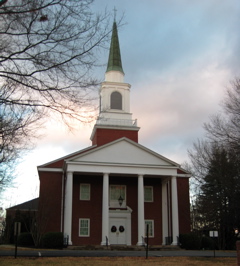The fertile river bottoms began to draw a few European settlers who followed the Great Wagon Road in the mid-18th century. By 1850, the area included large plantations along the Yadkin River, which were dependent on slave labor, as well as a few smaller farms.
The area was first known as Red Plains, likely for the red soil in the area. A school and post office were located there. Because there was no road nearby, only paths through the woods led to the school. [4] A post office called Mana was at one time located in the area. [5]
Enon Baptist Church was founded in 1858. Members first met at the Red Plains School, near the home of Tyre Glen. The name Enon was chosen because of its proximity of the Yadkin River. Enon is an alternate spelling for Ænon, a Greek word for spring. [6] The church began with eight members, including John, a slave of Tyre Glen. The first church building included a balcony for slave members.
Civil War period
Tyre Glen or Tyree Glenn (1800–1875) built one of the largest plantations in western North Carolina, in Enon. The estate, known as Glenwood, once had 360 slaves and 6,000 acres (24 km2). [7] The 15-room house, with its Doric columns, was completed in 1837. The soapstone foundation for the house came from Glen's own quarry. Recently, it was restored and is a privately owned residence. Glen's property included a dam, gristmill and a ferry at the Yadkin River.
Glen spent his early career as a slave trader and land broker, helping set up plantations in Mississippi. Glen's papers are available through Duke University Libraries and have been cited in recent books on the Civil War period. [8] Among the records, is a price table from the early 1850s that values slaves based on their ages. [9] Glenwood was a center for culture in the area. Prominent visitors included Nathan Rudolphus., the son of Sen. Stephen A. Douglas; North Carolina Gov. Zebulon Vance; and North Carolina Chief Justice Richard M. Pearson.
In 1863, a company of 50 uninvited Confederate troops of the 8th Battalion Georgia Infantry descended on Glenwood. In April 1863, Glen's rants against secession angered the officers, who instigated a plot to lure him from Glenwood and hang him as a traitor. The officers' plot was stopped by heavy rains that washed away the bridge at Deep Creek, and Glen returned to his home. [10]
In July 1864, William Alexander Conrad, a founding member of Enon Baptist Church and member of the Home Guard, was shot at Glenn's Ferry, trying to catch what he thought were three deserters who were crossing the river in a small boat. Conrad died several months later. Years after the war, it was learned that the men were Union soldiers who had escaped from prison and were on their way to Ohio. [11]
Glenwood was raided several times during the close of the Civil War. After the last raid, in April 1865, most of the slaves had fled, and there was neither a horse nor a head of cattle left. [12] As the Confederate army disbanded, troops marched along the ferry road that ran through the estate. For weeks, long tables were erected at each side of the house and family members and the few remaining freedmen gave food to all who stopped.
A partner in the slave trade with Glen, Isaac Jarratt (1812–1875), also settled in the Enon area. Jarratt, who served as a drummer boy during the War of 1812, bought the Davis Durrett plantation in 1835. Many of the Jarratt family papers, including letters and slave receipts, are located in the library at the University of North Carolina at Chapel Hill. [13] During the Civil War, Isaac Jarratt was captain of the Yadkin County Home Guard.
The Jarratt family is also tied to the families of Thomas Lanier Clingman and through marriage to Richard Clauselle Puryear of nearby Huntsville. [14] The Durrett-Jarratt House, on Old U.S. Highway 421, is listed on the National Register of Historic Places. [15]
Later development
The community remained isolated after the Civil War. In 1913, the first bridge across the Yadkin River at Enon was authorized by the North Carolina Legislature. The steel bridge was completed a short time before a sand-clay road was built in 1915. The road, which linked Winston-Salem to Yadkinville, was paved in 1925 and became part of U.S. Highway 421. [16] The highway gave the area easier access to Winston-Salem, which is less than 10 miles (16 km) east.
At least four country stores and a roller mill opened along the highway, offering gas and other conveniences to locals and travelers along the highway. However, the stores began closing in the 1960s after a new four-lane U.S. 421 was built a few miles south of the community. The former U.S. highway is now called Old U.S. 421.
In 1936, High Point began an ill-fated plan to build an 85-foot (26 m) deep lake and hydroelectric dam in an area that included portions the community. High Point bought up more than 14,000 acres (57 km2) along the Yadkin River for the Styers Ferry dam project and had spent about $1 million before it was stopped by the courts. Local farmers and Duke Power mobilized to fight the plan. The dam project went before the state Supreme Court seven times. Finally, the federal government ended the project during World War II because generators were needed for the war effort. [17]


